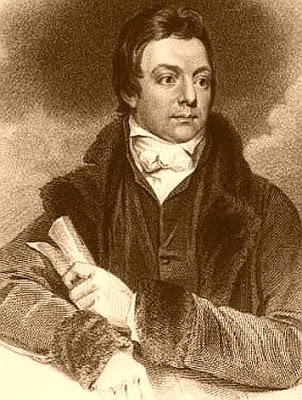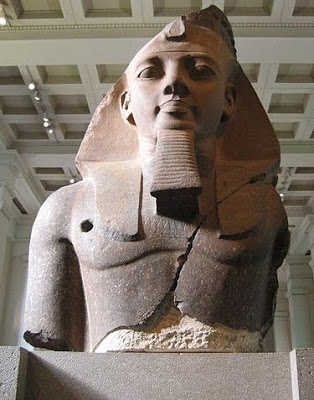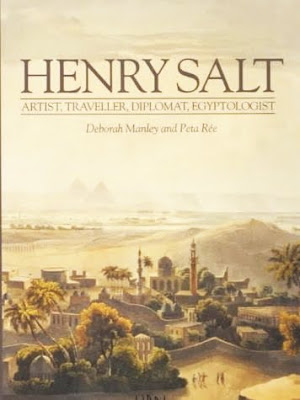Philosophy
 Henry Salt
Henry Salt
June 14th, 1780 to October 30th, 1827

Those must have been the good old days of plunder...long before the activities of Zahi Hawass, the flamboyant Secretary General of the Egyptian Supreme Council of Antiquities.
Bill Ashworth in the Linda Hall Library Newsletter wrote...
Henry Salt, a British diplomat, artist, and collector, was born June 14, 1780. In 1815, Salt was sent to Cairo as the British consul, and he immediately began collecting Egyptian artifacts. Bernardino Drovetti, a Frenchman who had collected for Napoleon and was now collecting for himself, provided direct competition, and Salt and Drovetti furiously tried to outdo each other in plundering Egypt of its artifacts. Salt hired a former strongman, Giovanni Belzoni, as his principal agent...and Belzoni performed some remarkable feats of pillage, including hauling a massive head of Ramesses II from the Ramesseum in Thebes to the Nile, where it was conveyed to Cairo. Salt then gave the remarkable granite head to the British Museum, where it still today rules over the Egyptian Room. Having whetted the British appetite with this gift, Salt then sold his entire collection of thousands of objects to the Museum in 1819 for thousands of pounds. Salt immediately began a second collection, and when the Museum balked this time at the price, he sold it--all four thousand objects--to France in 1824. His third and last collection was auctioned after his death in 1827, with most of the objects being bought by the British Museum, already regretting its previous tight-fistedness. The head of Ramesses II (sometimes called the “Younger Memnon”) is also famous for a literary reason: Percy Shelly was inspired by its coming to write Ozymandias, which begins: "I met a traveler from an antique land" and continues: "My name is Ozymandias, king of kings: Look on my works, ye mighty, and despair!"
Henry Salt [Wikipedia]
 Henry Salt., Artist Traveller, Diplomat, Egyptologist
Henry Salt., Artist Traveller, Diplomat, Egyptologist
by
Deborah Manley and Peta Rée
ISBN-10: 190196504X
ISBN-13: 978-1901965049
The birth of modem Egyptology is a subject that has been receiving more and more attention of late, with the republication of old manuscripts and histories of the characters involved. This book is a good addition to the burgeoning fold.
Henry Salt (1780-1827) was born the youngest of eight children in Lichfield, Staffordshire. There is very little discussion about Salt's early life, probably due to the difficulty in locating information. We do however learn of an illness that affected Salt's spleen sometime between the ages of eleven and fourteen. This illness would go on to plague him for the rest of his life. But the main thread of the book joins up with a fourteen year old Salt off to study Classics under the watchful eye of a big brother in Birmingham
A year later, Salt returns home with aspirations to be a portrait painter. For the next few years of his life, we follow Salt moving around and making friends, and revisiting old ones, as he follows his dreams. Salt could not have known what was just round the corner. In June 1802 he was off 'on a voyage to the East' with Viscount Valentia. By mid January India came into view, and along with it all manner of adventures. It was not until early 1806 that Salt sets foot in Egypt, the country he would later spend so much time in.
Not wanting to give the game away, once Salt is in Egypt the readers will find themselves completely engaged, as I did. Salt's infamous struggle with museums over antiquities he collected is well covered, as are his meetings with Belzoni (although 1 would have liked to know more about Belzoni's wife - she sounds like a book waiting to happen!), his excavations, his family life and finally his death and burial within the grounds of his own garden. All in all, this book provides an excellent biography on the life of Henry Salt and his adventures, and what a life he had!
- Calendar Denial
It's that time of year. The fall is just about here. Don't get me wrong. I love teaching. I love my students (especially the ones who read this blog). But I hate giving up summer. In fact, at this point I'm simply retreating into denial. If...
- Bolivia's Lithium Trains Are Rusting Away
"The Beautiful Junkyard Where Bolivia’s Trains Were Left to Rot" by Alex Davies August 7th, 2014 Wired Booming global demand for smartphones, tables, laptops, and electric cars has led to increased interest in Bolivia, home to the world’s...
- Salt And Prozac...the Debate Continues
Statistics can be misinterpreted. "What Salt and Prozac Have in Common" by Maia Szalavitz July 15th, 2011 Time Recently, two medical controversies have made headlines: the question of whether too much salt is bad for your health and the debate over...
- Before Zahi Hawass...gaston Maspero
Gaston Maspero June 23rd, 1846 to June 30th, 1916 Long before Zahi Hawass [current Secretary General of the Egyptian Supreme Council of Antiquities] there was Gaston Maspero a French Egyptologist and director general of excavations and antiquities for...
- Prussian Blue And Origin Of Life
Potassium ferrocyanide {K4[Fe(CN)6]•3H2O} [yellow prussiate of potash or potassium hexacyanoferrate(II)]...Potassium ferricyanide {K3[Fe(CN)6]} These two chemicals have had a colorful history...even their chemistry has been cloudy. But now it is believed...
Philosophy
Massive head of Ramesses II and Henry Salt
 Henry Salt
Henry SaltJune 14th, 1780 to October 30th, 1827

Those must have been the good old days of plunder...long before the activities of Zahi Hawass, the flamboyant Secretary General of the Egyptian Supreme Council of Antiquities.
Bill Ashworth in the Linda Hall Library Newsletter wrote...
Henry Salt, a British diplomat, artist, and collector, was born June 14, 1780. In 1815, Salt was sent to Cairo as the British consul, and he immediately began collecting Egyptian artifacts. Bernardino Drovetti, a Frenchman who had collected for Napoleon and was now collecting for himself, provided direct competition, and Salt and Drovetti furiously tried to outdo each other in plundering Egypt of its artifacts. Salt hired a former strongman, Giovanni Belzoni, as his principal agent...and Belzoni performed some remarkable feats of pillage, including hauling a massive head of Ramesses II from the Ramesseum in Thebes to the Nile, where it was conveyed to Cairo. Salt then gave the remarkable granite head to the British Museum, where it still today rules over the Egyptian Room. Having whetted the British appetite with this gift, Salt then sold his entire collection of thousands of objects to the Museum in 1819 for thousands of pounds. Salt immediately began a second collection, and when the Museum balked this time at the price, he sold it--all four thousand objects--to France in 1824. His third and last collection was auctioned after his death in 1827, with most of the objects being bought by the British Museum, already regretting its previous tight-fistedness. The head of Ramesses II (sometimes called the “Younger Memnon”) is also famous for a literary reason: Percy Shelly was inspired by its coming to write Ozymandias, which begins: "I met a traveler from an antique land" and continues: "My name is Ozymandias, king of kings: Look on my works, ye mighty, and despair!"
Henry Salt [Wikipedia]
 Henry Salt., Artist Traveller, Diplomat, Egyptologist
Henry Salt., Artist Traveller, Diplomat, Egyptologist by
Deborah Manley and Peta Rée
ISBN-10: 190196504X
ISBN-13: 978-1901965049
The birth of modem Egyptology is a subject that has been receiving more and more attention of late, with the republication of old manuscripts and histories of the characters involved. This book is a good addition to the burgeoning fold.
Henry Salt (1780-1827) was born the youngest of eight children in Lichfield, Staffordshire. There is very little discussion about Salt's early life, probably due to the difficulty in locating information. We do however learn of an illness that affected Salt's spleen sometime between the ages of eleven and fourteen. This illness would go on to plague him for the rest of his life. But the main thread of the book joins up with a fourteen year old Salt off to study Classics under the watchful eye of a big brother in Birmingham
A year later, Salt returns home with aspirations to be a portrait painter. For the next few years of his life, we follow Salt moving around and making friends, and revisiting old ones, as he follows his dreams. Salt could not have known what was just round the corner. In June 1802 he was off 'on a voyage to the East' with Viscount Valentia. By mid January India came into view, and along with it all manner of adventures. It was not until early 1806 that Salt sets foot in Egypt, the country he would later spend so much time in.
Not wanting to give the game away, once Salt is in Egypt the readers will find themselves completely engaged, as I did. Salt's infamous struggle with museums over antiquities he collected is well covered, as are his meetings with Belzoni (although 1 would have liked to know more about Belzoni's wife - she sounds like a book waiting to happen!), his excavations, his family life and finally his death and burial within the grounds of his own garden. All in all, this book provides an excellent biography on the life of Henry Salt and his adventures, and what a life he had!
- Calendar Denial
It's that time of year. The fall is just about here. Don't get me wrong. I love teaching. I love my students (especially the ones who read this blog). But I hate giving up summer. In fact, at this point I'm simply retreating into denial. If...
- Bolivia's Lithium Trains Are Rusting Away
"The Beautiful Junkyard Where Bolivia’s Trains Were Left to Rot" by Alex Davies August 7th, 2014 Wired Booming global demand for smartphones, tables, laptops, and electric cars has led to increased interest in Bolivia, home to the world’s...
- Salt And Prozac...the Debate Continues
Statistics can be misinterpreted. "What Salt and Prozac Have in Common" by Maia Szalavitz July 15th, 2011 Time Recently, two medical controversies have made headlines: the question of whether too much salt is bad for your health and the debate over...
- Before Zahi Hawass...gaston Maspero
Gaston Maspero June 23rd, 1846 to June 30th, 1916 Long before Zahi Hawass [current Secretary General of the Egyptian Supreme Council of Antiquities] there was Gaston Maspero a French Egyptologist and director general of excavations and antiquities for...
- Prussian Blue And Origin Of Life
Potassium ferrocyanide {K4[Fe(CN)6]•3H2O} [yellow prussiate of potash or potassium hexacyanoferrate(II)]...Potassium ferricyanide {K3[Fe(CN)6]} These two chemicals have had a colorful history...even their chemistry has been cloudy. But now it is believed...
